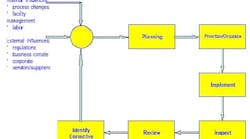When the classic original version of ISO 14001 was rolled out, many pundits were quick to extol the virtues of this sibling of ISO 9001 and what it could provide to a diverse array of regulated industries. Unfortunately for the ISO standard, the reality did not immediately match the marketing hype. Many organizations took a Let's wait and see attitude. If not for the Big Three automakers, ISO 14001 might not have won acceptance. The automakers pushed its suppliers to not just implement an environmental management system (EMS) but achieve ISO 14001 certification by a mandated deadline. Electronics companies, such as IBM, and consumer giants like Sony, also played their part in drawing the line in the sand with their suppliers to achieve certification.
Interestingly, some emerging global forces, such as the European Union's directives affecting life-cycle costs of electronic equipment, e.g., 2002/95/EC, 2002/96/EC, 2003/108/EC, commonly referred to as the Restriction of the Use of Certain Hazardous Substances in Electronic and Electrical Equipment (RoHS), and Waste Electrical and Electronic Equipment (WEEE), are influencing environmental policy. Meanwhile, in the United States, the Sarbanes-Oxley Act, regulating corporate accounting practices, and public disclosure of previously confidential records, may now have a part in shaping how EMSs and ISO stimulate business policy. Time will tell.
Not a paper chase
I queried a number of company managers about ISO 14001 certification, and whether they saw a need for continued EMS assistance. As I see it, certification to ISO 14001 is just the beginning. Here's a brief summary of some of the responses I received: We passed our inspection, we don't need any help.; We have our certificate, we're all set.
To which I replied, What about your internal auditing program? Did you conduct an initial audit and go through a complete cycle including management review?
No, were we supposed to, and is lead auditor training necessary? We only generate small stuff; we're a clean facility, why do we need all this ISO stuff?
Sound familiar? In one facility, that had been recommended for certification to ISO 14001, their management received an enforcement action for violations related to secondary tank containment.
Taking this point one step further, the U.K.s Environmental Data Service (ENDS, London) conducted a survey in 2003 to identify the factors that motivated companies to seek certification. Interestingly, internal motivation is the biggest single driver, followed closely by supply chain and competitive pressure. [1] In reality, as we have seen from our own unscientific mini-survey, some companies view certification as their end goal and become complacent, until its time for the next registrars audit.
That view can lead to situations that may compromise the organization, and unfortunately, is shared by too many companies. Whether its to maintain the ISO 14001 or 9001 or even OHSAS 18001 certificates, maintaining the system for the sake of the sheepskin is a Pyrrhic victory of sorts. The real value to the organization is lost in translation somehow.
Let's take this argument one step further and take a closer look at a few key elements of ISO 14001:2004(E). Interestingly, those elements that were revamped were done so because too many certified organizations took the bare-bones minimal approach to develop an EMS that would pass the registrar's muster. That's why I believe the communications section was revamped, and a new clause 4.5.2 Evaluation of compliance was spun off from the original 4.5.1 Monitoring and measurement. Too many organizations, while developing and maintaining their EMS, were taking ill-advised shortcuts shortcuts that unfortunately are not one-size-fits-all. As I found out from my own experience, short cuts are no substitute for a quality product, and oversight is mandatory.
Making ISO-14001 work
So what should you look for in developing and eventually maintaining your EMS? The following is a 10-step program that may eliminate some nasty pinch points that could be dragging down the effectiveness of your EMS program:
The payoff
Having worked on EMS-related issues for quite some time, I have seen a number of issues related to management system shortfalls. I also have seen companies that were committed to continually improve their EMSs. They were truly committed to seeking areas for savings in resources and manpower, while striving to minimize waste streams, and fully empower their employees to make the important day-to-day decisions. Satisfying the registrar was more of an attaboy than the primary goal. Like Demmings quality management method, ISO-14001 is a continuous improvement plan (Figure 1). These companies understand that having an EMS at peak performance will take care of itself, and everything else will fall in line. That is the true intent of ISO 14001, not the sheepskin or the banner. We should never lose sight of that.

